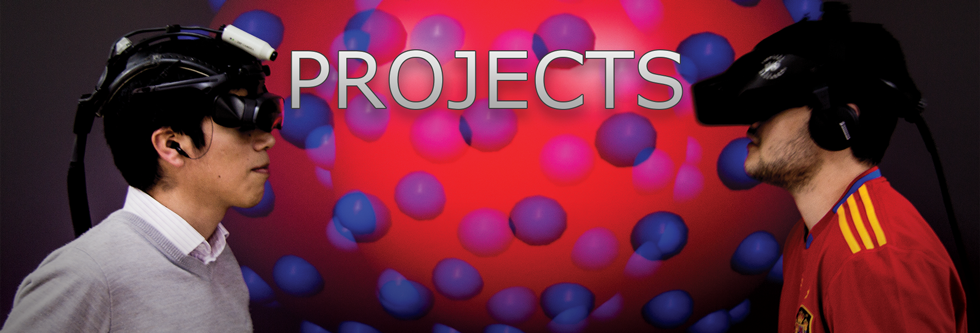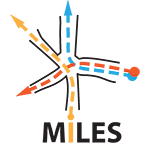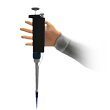

MILES (Models of Interaction centred on Langauage, spacE and computational Semantics)
January 2010 to Present
Show descriptionThe main goal of this project is to develop an architecture for interactive systems that combines a dialogue engine, a natural language generator, and a semantic representation based on ontologies covering both the real (or virtual) physical space and the user located within it.
In this project we intend to apply technological solutions for interaction to resolve difficulties in perception or localization that a real user might have with a particular spatial environment. For the purpose of this project, special attention will be paid to users with different types of functional diversity (different degrees in their ability to perceive or move about the environment). With a view to developing the necessary technology, we will work with real environments and with virtual simulations of them. Over the last few years there have been significant advances in the areas of dialogue systems, natural language generation, and virtual environments. However, in spite of the fact that these areas all have in common that they deal with person-computer interactions with an important presence of natural language components, there has been very little work centred in the conjunction of the three areas.
The coordinated project contemplates both the development of an architecture for managing interactions and its validation over a series of specific case studies. The three participating research groups take part in the initial specification of the architecture and the development of a base line for it based on integrating solutions to specific partial problems previously developed by different participants. Once this baseline architecture is established, each group will work on applying it to a different context. The idea is to test the ease with which this solution can be adapted to specific tasks and how well different settings can be represented, both in terms of restrictions on space and interaction. Each case study that is contemplated will be the responsibility of one of the participating research groups.
The NOVA (Navigating with Ontology-based Verbal Assistance) subproject will focus on the task of guiding a user by means of verbal instructions and descriptions around a physical space unknown to him. Special attention will be paid to users with different types of functional diversity (different degrees in their ability to perceive or move about). An application to assist patients when moving between different locations of a big public hospital will be used as test case. The SEPIA (Semantic models of Environments and Persons for Interaction Adapted to their needs in virtual environments) subproject will concern itself with the use of ontologies for representation of and reasoning about spatial concepts and their interaction with path finding and a representation of the perception of user. As case study, it will use an application that simulates in a virtual environment the evacuation protocols of a nuclear power station. The DIMMO (DIalogue MultiModality based on Ontologies) subproject will address the development of advanced dialogue management solutions that take into account the selection of dialogue moves and multimodal presentation guided by ontologies. As a case study it will focus on assisting the navigation of a complex web site by means of 2D avatars acting as virtual guides.

PIVE (Platform for Intelligent Virtual Environment for Education)
October 2011 to October 2012
Show descriptionThis project is the continuation of the educational innovation project PEIA developed between October 2010 and September 2011. PEIA project explored the possibilities of virtual worlds as an educational tool in teaching some subjects taught at the UPM as well as studied the integration of these virtual worlds with Moodle platform. To this end, four prototypes of virtual labs were developed using the platform OpenSim: biotechnology laboratory, irrigation control laboratory, electronics laboratory and physics lab.
OpenSim is an open source platform and free, which provides many facilities to develop multiuser virtual environments with good quality at a relatively low cost.
In the current project the researchers of LDC have continued with the development of the biotechnology lab and the irrigation control laboratory. Next, these labs will be described briefly:
The virtual laboratory of biotechnology has a building where students can find the instruments and equipment required to perform genetic engineering practices. More concretely, this project is focusing on implementing the virtual lab so as to allow one or more students to perform a practice in which they have to genetically modify a tree (poplar) in order to increase its resistance to diseases caused by fungi. In addition, the laboratory has an intelligent tutoring system capable of providing assistance to students as they perform the practice. You can see a video demonstration of this lab.
The irrigation control virtual laboratory consists in a virtual environment which represents several plots with corn and the mechanisms necessary to irrigate each plot. In this context the students are in charge of scheduling irrigation of the plots assigned to them considering the weather forecast and the terrain specifics. When scheduling irrigation, the student should try to make the most of the cultivation minimizing water consumption. You can see a video demonstration of this lab.

Technological advances are of paramount importance for the provision of future rehabilitation services, since they allow the personalization of interventions, the tuning of the intensity and length of programs, to supervise both in real time and off-line, and to obtain knowledge coming from the clinical practice and its structure. All this will lead to safer, more efficient and more effective interventions, allowing to build a new paradigm of rehabilitation procedures, based on clinic evidence, and efficiency and effective-oriented.
The kind of rehabilitation obtained through the new paradigm must be:
- personalized, supervised and ubiquitous
- offering a continuous evaluation of the procedures effectiveness and efficiency
- able to provide knowledge to make a breakthrough regarding the current paradigm
- able to minimize the impact of sickness on the functional ability of people
- able to reduce the temporal working disability
- able to manage resources in a more efficient way
- able to have an effect in the reduction of the global estimated cost of the major impact processes on the society.
The challenge of rehabilitation is not to achieve the recovering of the bigger number of functions, but the reorganization of the remaining functional ability towards the response patterns more adaptive. In this moment, those patterns are unknown, and the recovering of the diverse functions studied have been oriented to the recovering of the bigger number possible of patterns. All these premises push the research of new technologies and the generation of a knowledge able to overpass nowadays barriers in rehabilitation. With this aim, the REHABILITA project has created a consortium of companies with vocation and recognized experience in technological innovation, research centers in biomedical, electronic, information and communication, and robotic technologies, together to clinical research centers of excellence in innovative rehabilitation procedures.
The technical objectives of the project conform a series of disruptive technologies essential to the new rehabilitation paradigm, in research areas as complex as:
- personalized, supervised and ubiquitous
- intelligent sensoactive fabrics
- context dependent interactive virtual environments
- gesture-based and intentional input/output interactive devices
- safe and interoperable virtual networks of clinic information
- hybrid bionic devices with advanced perceptive and active capabilities
- intelligent therapy and learning adaptation.
Inside the project, LDC-UPM uses its experience in intelligent personalized systems for learning and training to apply them in medical rehabilitation processes, establishing a parallelism that will allow an intelligent, personalized and dynamic adaptation of the therapy, in order to make it more efficient to the patient.

In spite of the powerful tools which are available nowadays to make easy the access of information contained into huge document collectios, like WWW, it hasn’t been found totally satisfactory solutions yet which allow not only to easily locate potentially interesting documents but also solutions that: 1) help user to build a mental model on a set of documents (the whole collection or a query result), 2) allow user to explore a collection and interact with it in a intuitive way in order to reorganize it or express his/her interests and preferences, or 3) are be able to dinamically adapt on the basis of user features, observed-user behaviors, or task features. Thus, we have found that there are still problems to resolve, some of them are the purpose of this project.
The approach we propose in order to solve this problem has its foundation in three main axis:
- We will try to find a new approach for conceptual modelling of document collections which allows to incorporate: thematic similarity analysis, semantic knowledge based on ontologies about both the document content and its structure and features, definition of excitatory and inhibitory relations among documents, and learning and evolution mechanisms.
- We will start from the hypothesis that mechanisms used for visualizing information and techniques and technologies available for the user to interact with the universe of information are determinant to give a more effective help to user. We assume also that the most modern 3D virtual reality technologies, augmented reality for mobile devices, and touch interfaces are elements that can significantly contribute to design new more intuitive, powerful, versatile and adaptive mechanisms.
- We will start from the hypothesis that exploration and interaction of a huge document collection, in order to locate relevant information, to build a mental model of that, to cover a coherent itinerary to satisfy learning objectives, or to refine its content and structure, would be absolutely favored due to the incoproration of user-modelling mechanisms, task-modelling mechanisms, and dynamic adaptation of a system which is able to act as an exploration-guide mechanism and not only as a search engine. We will try to take advantage of both virtual and augmented reality technologies to observe and track the user actions.
This project proposes to advance in practical demonstration of new scientific knowledge generated through the development of a set of prototypes and study cases. Over these prototypes we will carry out empirical evaluations that determine the advantages and disadvantages of proposed solutions, and evaluate their behavior and possibilities.

